Freeform Phononic Waveguides
Abstract
:1. Introduction
2. Phononic Band Gaps in Two-Dimensional HDPS
2.1. The Hyperuniform Structure
2.2. Band Structure for Out-of-Plane Elastic Wave Modes
2.3. Band Structure for in-Plane Elastic Wave Modes
3. Freeform Waveguides
3.1. 2D Modes in Nearly-Hyperuniform Structures
3.2. Out-of-Plane 2D Waveguide Modes
3.3. In-Plane 2D Waveguide Modes
3.4. Waveguide Modes in 3D Slabs
4. Conclusions
Supplementary Materials
Acknowledgments
Author Contributions
Conflicts of Interest
References
- Kushwaha, M.S.; Halevi, P. Band-gap engineering in periodic elastic composites. Appl. Phys. Lett. 1994, 64, 1085. [Google Scholar]
- Deymier, P.A. Acoustic Metamaterials and Phononic Crystals; Springer Science & Business Media: New York, NY, USA, 2013; Volume 173. [Google Scholar]
- Vasseur, J.O.; Deymier, P.A.; Khelif, A.; Lambin, P.; Djafari-Rouhani, B.; Akjouj, A.; Dobrzynski, L.; Fettouhi, N.; Zemmouri, J. Phononic crystal with low filling fraction and absolute acoustic band gap in the audible frequency range: A theoretical and experimental study. Phys. Rev. E 2002, 65, 056608. [Google Scholar]
- Li, X.F.; Ni, X.; Feng, L.; Lu, M.H.; He, C.; Chen, Y.F. Tunable unidirectional sound propagation through a sonic-crystal-based acoustic diode. Phys. Rev. Lett. 2011, 106, 084301. [Google Scholar]
- Sukhovich, A.; Jing, L.; Page, J.H. Negative refraction and focusing of ultrasound in two-dimensional phononic crystals. Phys. Rev. B 2008, 77, 014301. [Google Scholar]
- Aspelmeyer, M.; Kippenberg, T.J.; Marquardt, F. Cavity optomechanics. Rev. Mod. Phys. 2014, 86, 1391–1452. [Google Scholar]
- Maldovan, M. Sound and heat revolutions in phononics. Nature 2013, 503, 209217. [Google Scholar]
- Davis, B.L.; Hussein, M.I. Nanophononic metamaterial: Thermal conductivity reduction by local resonance. Phys. Rev. Lett. 2014, 112, 055505. [Google Scholar]
- Lv, H.; Tian, X.; Wang, M.Y.; Li, D. Vibration energy harvesting using a phononic crystal with point defect states. Appl. Phys. Lett. 2013, 102, 034103. [Google Scholar]
- Schuler, C.J.; Wolff, C.; Busch, K.; Florescu, M. Thermal emission from finite photonic crystals. Appl. Phys. Lett. 2009, 95, 241103. [Google Scholar] [Green Version]
- Yuan, Z.D.; Chen, J.C. Elastic wave propagation in two-dimensional ordered and weakly disordered phononic crystals. Chin. Phys. Lett. 2005, 22, 889–891. [Google Scholar]
- Wagner, M.R.; Graczykowski, B.; Reparaz, J.S.; Sachat, A.E.; Sledzinska, M.; Alzina, F.; Torres, C.M.S. Two-Dimensional phononic crystals: Disorder matters. Nano Lett. 2016, 16, 5661–5668. [Google Scholar]
- Still, T.; Cheng, W.; Retsch, M.; Sainidou, R.; Wang, J.; Jonas, U.; Stefanou, N.; Fytas, G. Simultaneous occurrence of structure-directed and particle-resonance-induced phononic gaps in colloidal films. Phys. Rev. Lett. 2008, 100, 194301. [Google Scholar]
- Chen, A.L.; Wang, Y.S. Study on band gaps of elastic waves propagating in one-dimensional disordered phononic crystals. Physica B 2007, 392, 369–378. [Google Scholar]
- Tourin, A.; Van Der Biest, F.; Fink, M. Time reversal of ultrasound through a phononic crystal. Phys. Rev. Lett. 2006, 96, 104301. [Google Scholar]
- Wang, Y.Z.; Li, F.M.; Huang, W.H.; Wang, Y.S. The propagation and localization of Rayleigh waves in disordered piezoelectric phononic crystals. J. Mech. Phys. Solids 2008, 56, 1578–1590. [Google Scholar]
- Davies, B.; King, A.; Newman, P.; Minett, A.; Dunstan, C.R.; Zreiqat, H. Hypothesis: Bones toughness arises from the suppression of elastic waves. Sci. Rep. 2014, 4, 7538. [Google Scholar]
- Shekhawat, A.; Zapperi, S.; Sethna, J.P. From damage percolation to crack nucleation through finite size criticality. Phys. Rev. Lett. 2013, 110, 185505. [Google Scholar]
- Zen, N.; Puurtinen, T.A.; Isotalo, T.J.; Chaudhuri, S.; Maasilta, I.J. Engineering thermal conductance using a two-dimensional phononic crystal. Nat. Commun. 2014, 5, 3435. [Google Scholar]
- Limonov, M.F.; De La Rue, R.M. Optical Properties of Photonic Structures: Interplay of Order and Disorder; CRC Press, Taylor & Francis Group: Boca Raton, FL, USA, 2012. [Google Scholar]
- Gkantzounis, G.; Amoah, T.; Florescu, M. Hyperuniform disordered phononic structures. Phys. Rev. B 2017, 95, 094120. [Google Scholar]
- Chen, A.L.; Wang, Y.S.; Li, J.B.; Zhang, C. Localisation of elastic waves in two-dimensional randomly disordered solid phononic crystals. Waves Random Complex 2010, 20, 104–121. [Google Scholar]
- Torquato, S.; Stillinger, F.H. Local density fluctuations, hyperuniformity, and order metrics. Phys. Rev. E 2003, 68, 041113. [Google Scholar]
- Florescu, M.; Torquato, S.; Steinhardt, P.J. Designer disordered materials with large, complete photonic band gaps. Proc. Natl. Acad. Sci. USA 2009, 106, 20658. [Google Scholar]
- Uche, O.U.; Torquato, S.; Stillinger, F.H. Collective coordinates control of density distributions. Phys. Rev. E 2006, 74, 031104. [Google Scholar]
- Batten, R.D.; Stillinger, F.H.; Torquato, S. Classical disordered ground states: Super-Ideal gases, and stealth and equi-luminous materials. J. Appl. Phys. 2008, 104, 033504. [Google Scholar]
- Florescu, M.; Torquato, S.; Steinhardt, P.J. Effects of random link removal on the photonic band gaps of honeycomb networks. Appl. Phys. Lett. 2010, 97, 10–13. [Google Scholar]
- Amoah, T.; Florescu, M. High-Q optical cavities in hyperuniform disordered materials. Phys. Rev. B 2015, 91, 020201(R). [Google Scholar]
- Tsitrin, S.; Williamson, E.P.; Amoah, T.; Nahal, G.; Chan, H.L.; Florescu, M.; Man, W. Unfolding the band structure of non-crystalline photonic band gap materials. Sci. Rep. 2015, 5, 13301. [Google Scholar] [Green Version]
- Sellers, S.R.; Man, W.; Sahba, S.; Florescu, M. Local self-uniformity in photonic networks. Nat. Commun. 2017, 8, 14439. [Google Scholar]
- Sato, A.; Pennec, Y.; Yanagishita, T.; Masuda, H.; Knoll, W.; Djafari-Rouhani, B.; Fytas, G. Cavity-type hypersonic phononic crystals. New J. Phys. 2012, 14, 113032. [Google Scholar]
- Yudistira, D.; Boes, A.; Graczykowski, B.; Alzina, F.; Yeo, L.Y.; Sotomayor Torres, C.M.; Mitchell, A. Nanoscale pillar hypersonic surface phononic crystals. Phys. Rev. B 2016, 94, 094304. [Google Scholar]
- Gorishnyy, T.; Ullal, C.K.; Maldovan, M.; Fytas, G.; Thomas, E.L. Hypersonic phononic crystals. Phys. Rev. Lett. 2005, 94, 115501. [Google Scholar]
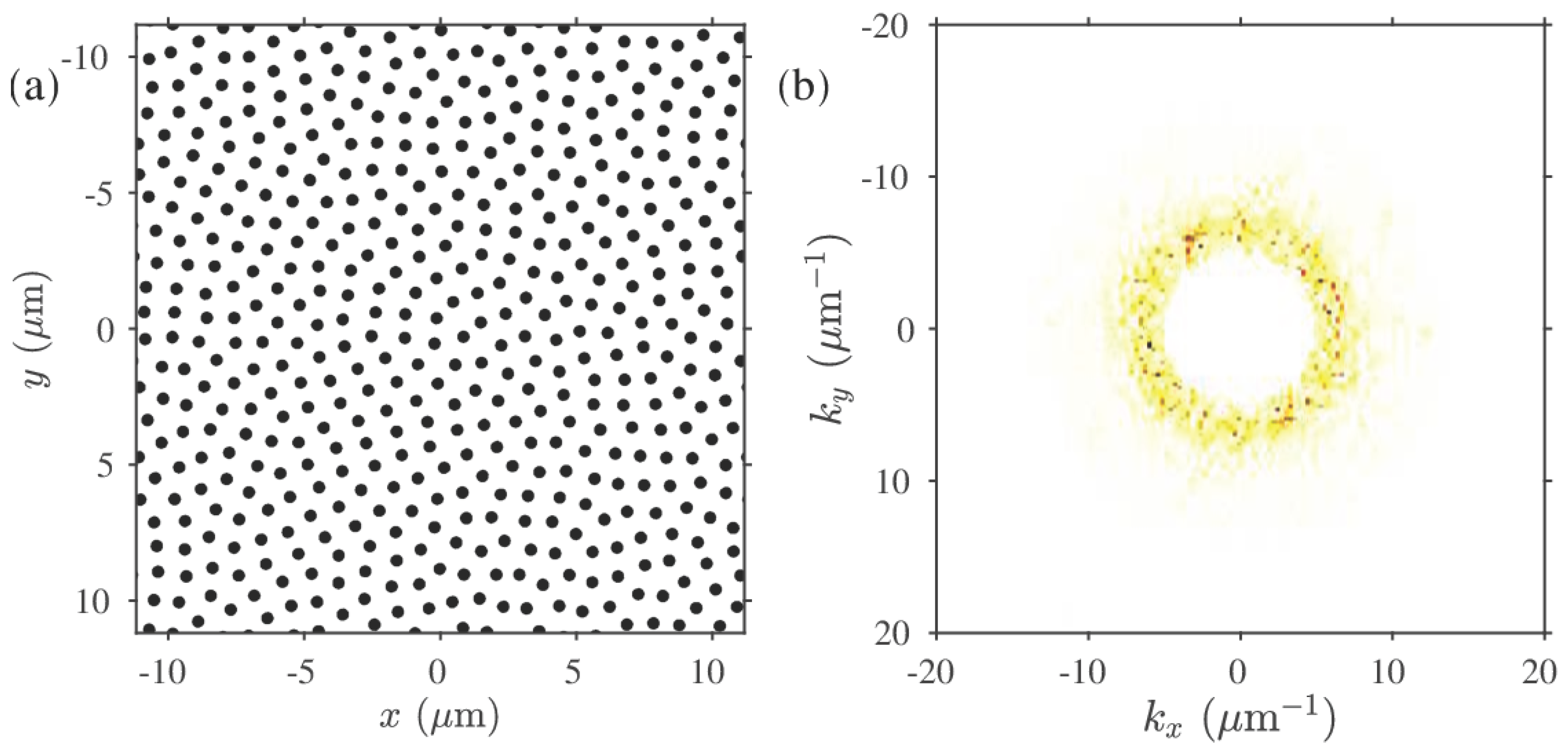
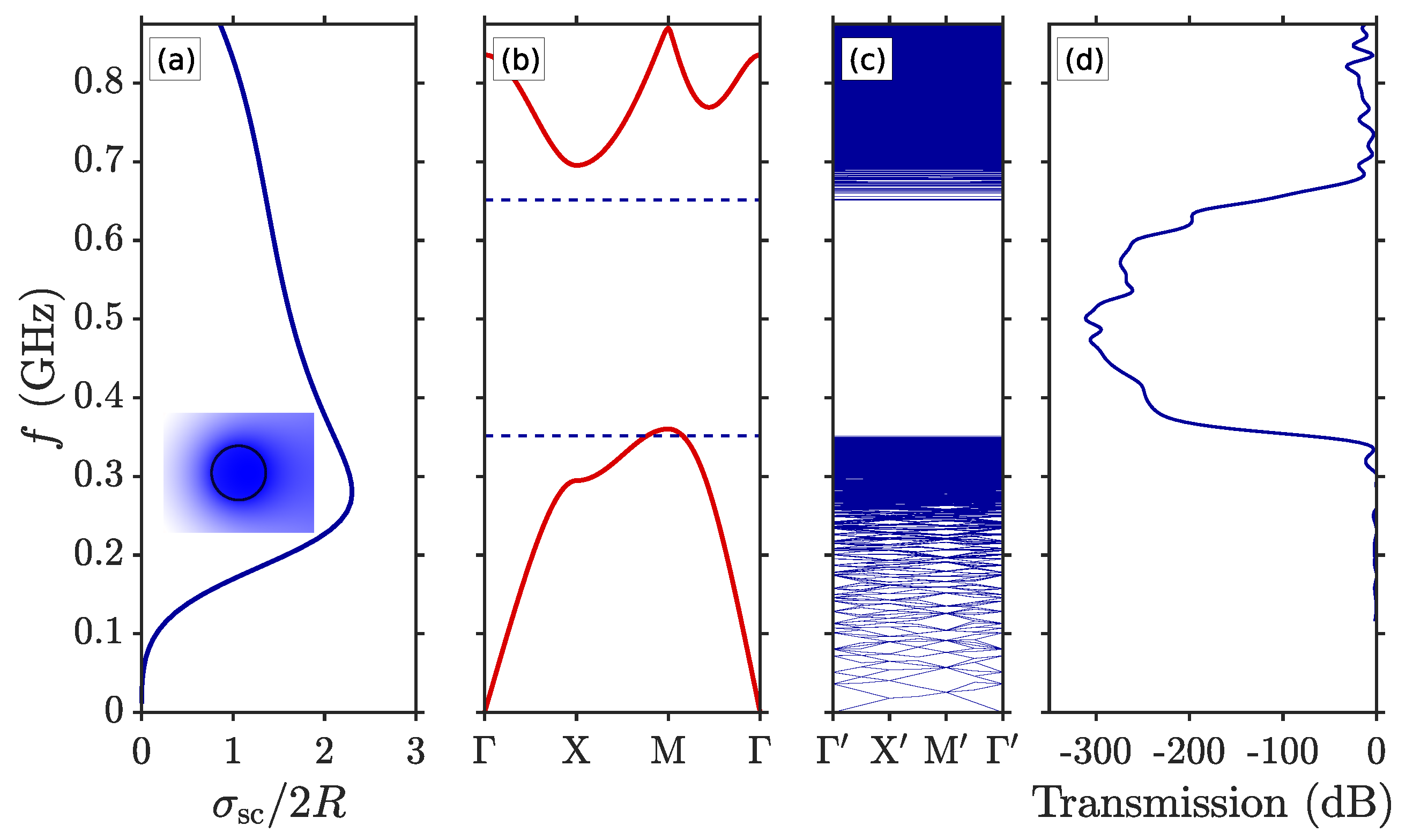
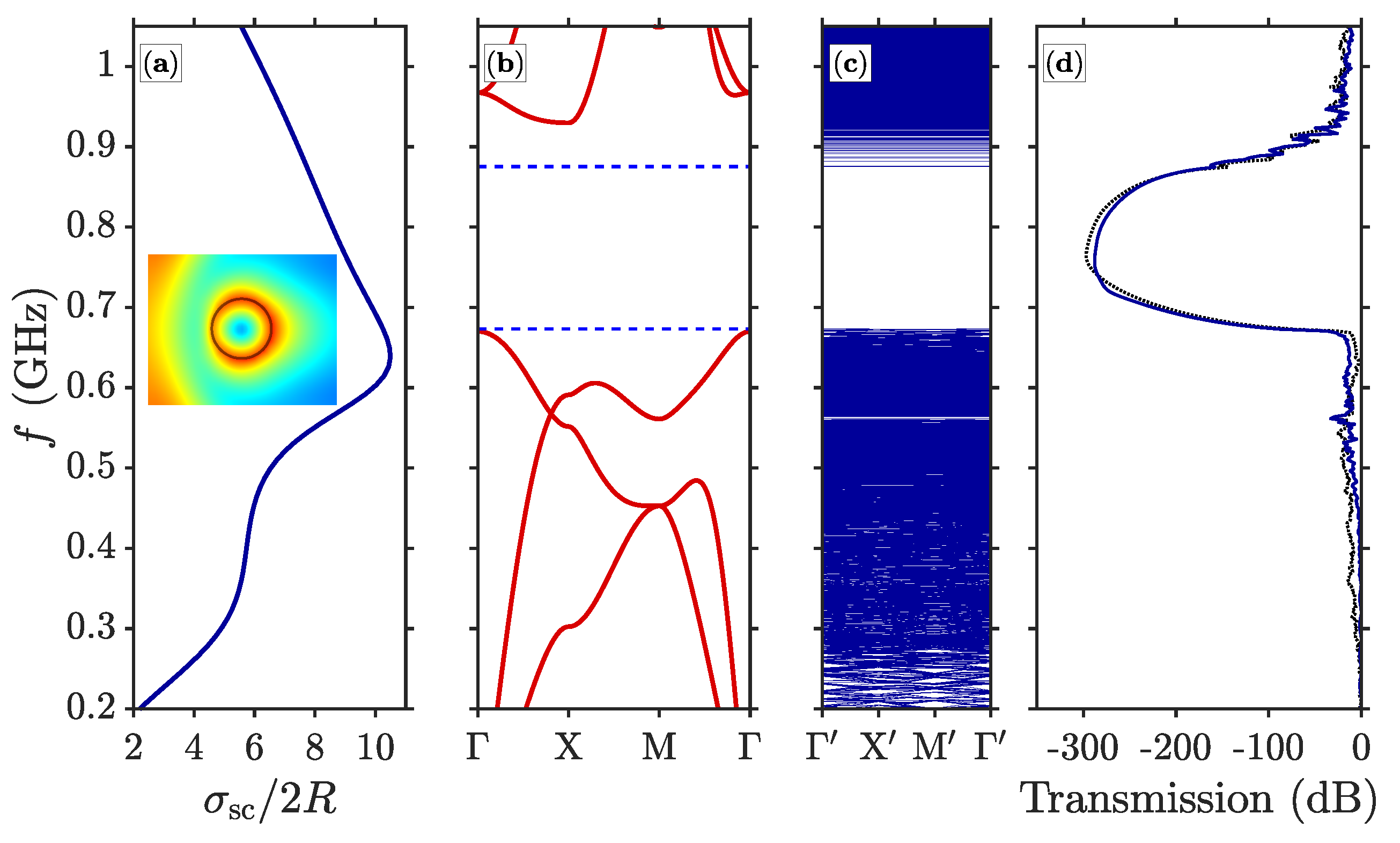

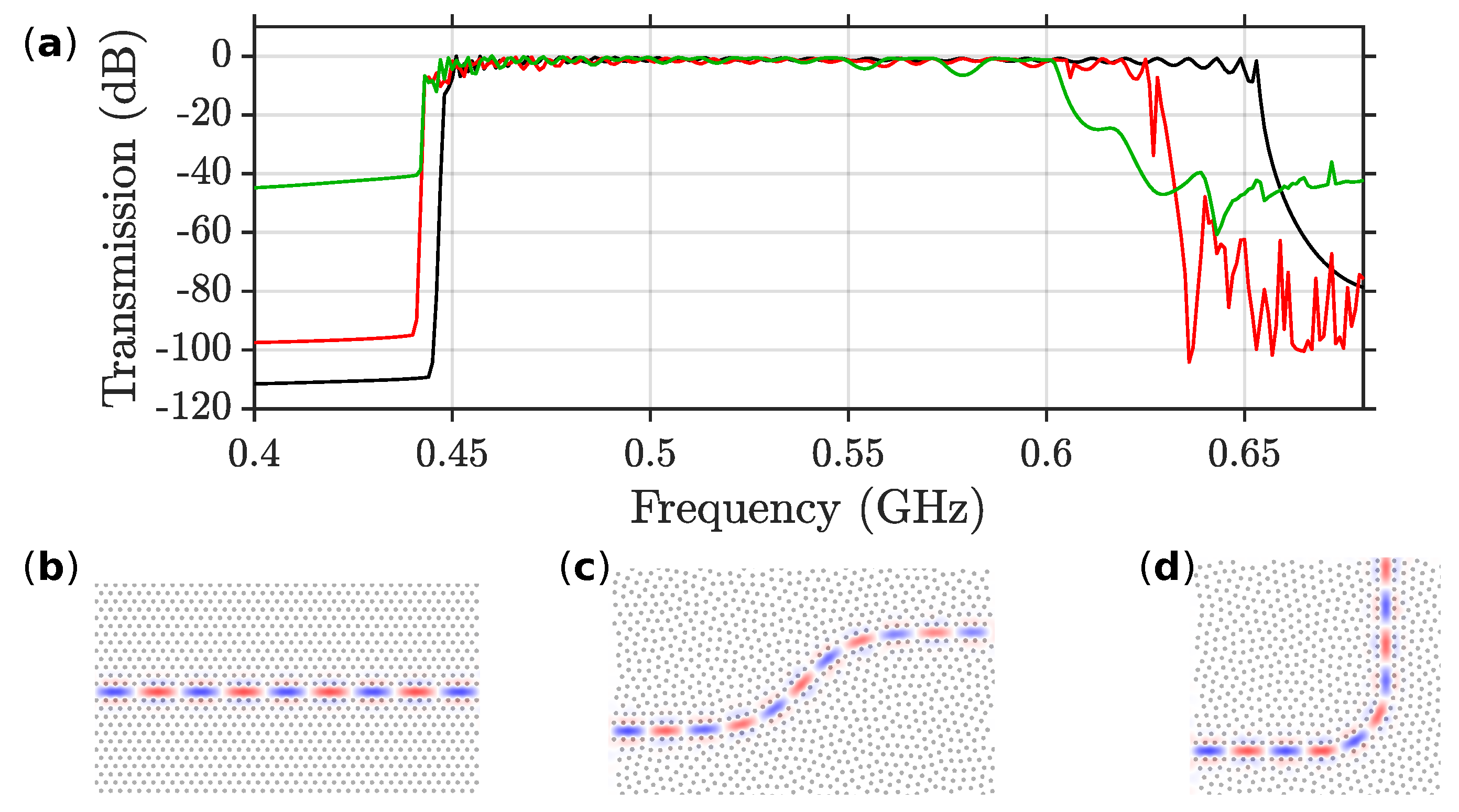
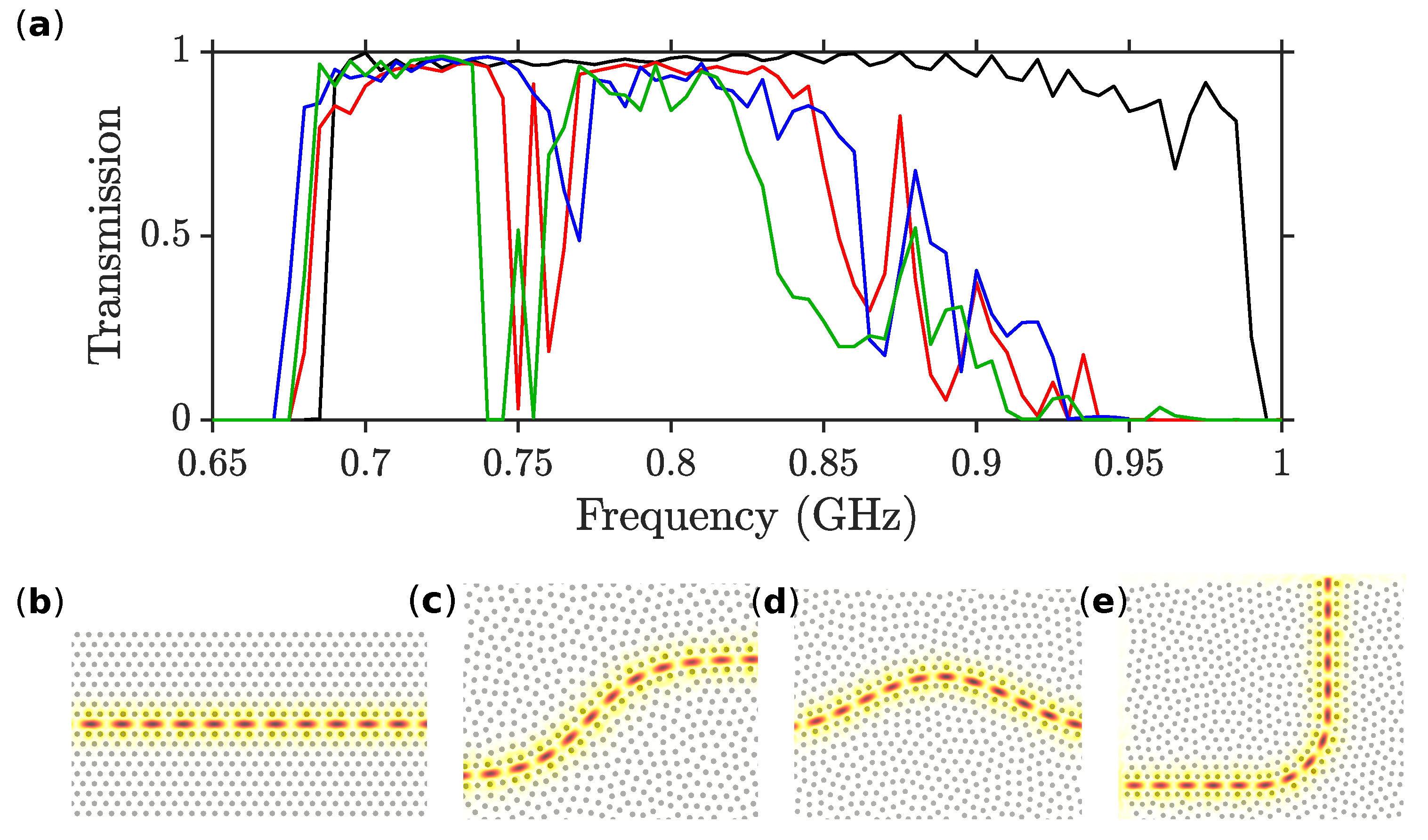

© 2017 by the authors. Licensee MDPI, Basel, Switzerland. This article is an open access article distributed under the terms and conditions of the Creative Commons Attribution (CC BY) license (http://creativecommons.org/licenses/by/4.0/).
Share and Cite
Gkantzounis, G.; Florescu, M. Freeform Phononic Waveguides. Crystals 2017, 7, 353. https://doi.org/10.3390/cryst7120353
Gkantzounis G, Florescu M. Freeform Phononic Waveguides. Crystals. 2017; 7(12):353. https://doi.org/10.3390/cryst7120353
Chicago/Turabian StyleGkantzounis, Georgios, and Marian Florescu. 2017. "Freeform Phononic Waveguides" Crystals 7, no. 12: 353. https://doi.org/10.3390/cryst7120353





